Step into the future of social interaction, where ownership, control, and decentralized communities redefine your online experience.
In this comprehensive guide, you'll discover:
- The fundamental principles of Web3 social media and its contrast with Web2.
- Key platforms and their unique approaches to decentralization, security, and monetization.
- How blockchain, smart contracts, and DAOs power these new social networks.
- Innovative strategies for creators to monetize content and build direct fan engagement.
- The mechanisms that ensure censorship resistance in Web3 environments.
- Practical steps and considerations for migrating from Web2 to Web3 social platforms.
Introduction to Web3 Social Media
The digital landscape is undergoing a profound transformation, shifting from the centralized, data-exploitative models of Web2 social media to a more user-centric paradigm known as Web3 social media. This evolution is driven by a desire for greater user ownership, robust censorship resistance, and innovative monetization opportunities. As users become increasingly aware of their digital rights and the value of their data, decentralized platforms are emerging as powerful alternatives that empower individuals and foster open online communities.
This guide will navigate you through the exciting world of Web3 social media, introducing you to the core concepts, the leading platforms, and the underlying technologies that make them possible. We'll explore how blockchain, smart contracts, and DAOs are reshaping social interactions, enabling creators to monetize their content directly, and ensuring that your voice can be heard without fear of arbitrary suppression.
What is Web3 Social Media?
Web3 social media refers to social networking platforms built on decentralized technologies, primarily blockchain. Unlike traditional Web2 platforms such as Facebook, Twitter (now X), or Instagram, where a single company controls user data, algorithms, and content policies, Web3 platforms distribute control among users. This decentralization is achieved through technologies like distributed ledgers, peer-to-peer networks, and cryptographic principles. Key characteristics include user ownership of data and digital identity, transparent and auditable governance, and often, built-in mechanisms for tokenized economies and creator compensation. The fundamental difference lies in the shift of power from platform owners to the community of users, fostering a more equitable and open digital space.
Why Decentralization Matters
The benefits of decentralization in social media are far-reaching, addressing many of the critical issues plaguing current Web2 platforms. Data ownership is paramount; in Web3, users truly own their data, deciding how it's shared and monetized, rather than relinquishing control to a central authority. This naturally leads to enhanced privacy, as personal information is secured through cryptography and distributed storage, making it resistant to breaches and exploitation. Crucially, decentralization provides censorship resistance. By operating on distributed networks rather than single servers, Web3 platforms are inherently more difficult to control or shut down by any single entity, including governments or corporations, ensuring freedom of expression. This foundational shift creates a more trustworthy, secure, and user-empowered online environment.
Overview of Key Features
Web3 social media platforms integrate several advanced features that distinguish them from their Web2 predecessors. Tokenization is a cornerstone, allowing for digital assets that can represent ownership, access, or value, enabling novel economic models where creators and users are rewarded directly. Smart contracts act as self-executing agreements on the blockchain, automating processes like content distribution, royalty payments, and community governance with transparency and reliability. Decentralized Autonomous Organizations (DAOs) empower communities to collectively manage platforms, make decisions through voting, and share in the platform's success, mimicking democratic governance structures. Furthermore, AI-powered tools are increasingly being integrated to enhance user experiences, provide personalized content feeds, and assist in content moderation in a decentralized manner, often while preserving user privacy. These interconnected technologies form the backbone of a more open, fair, and engaging social web.
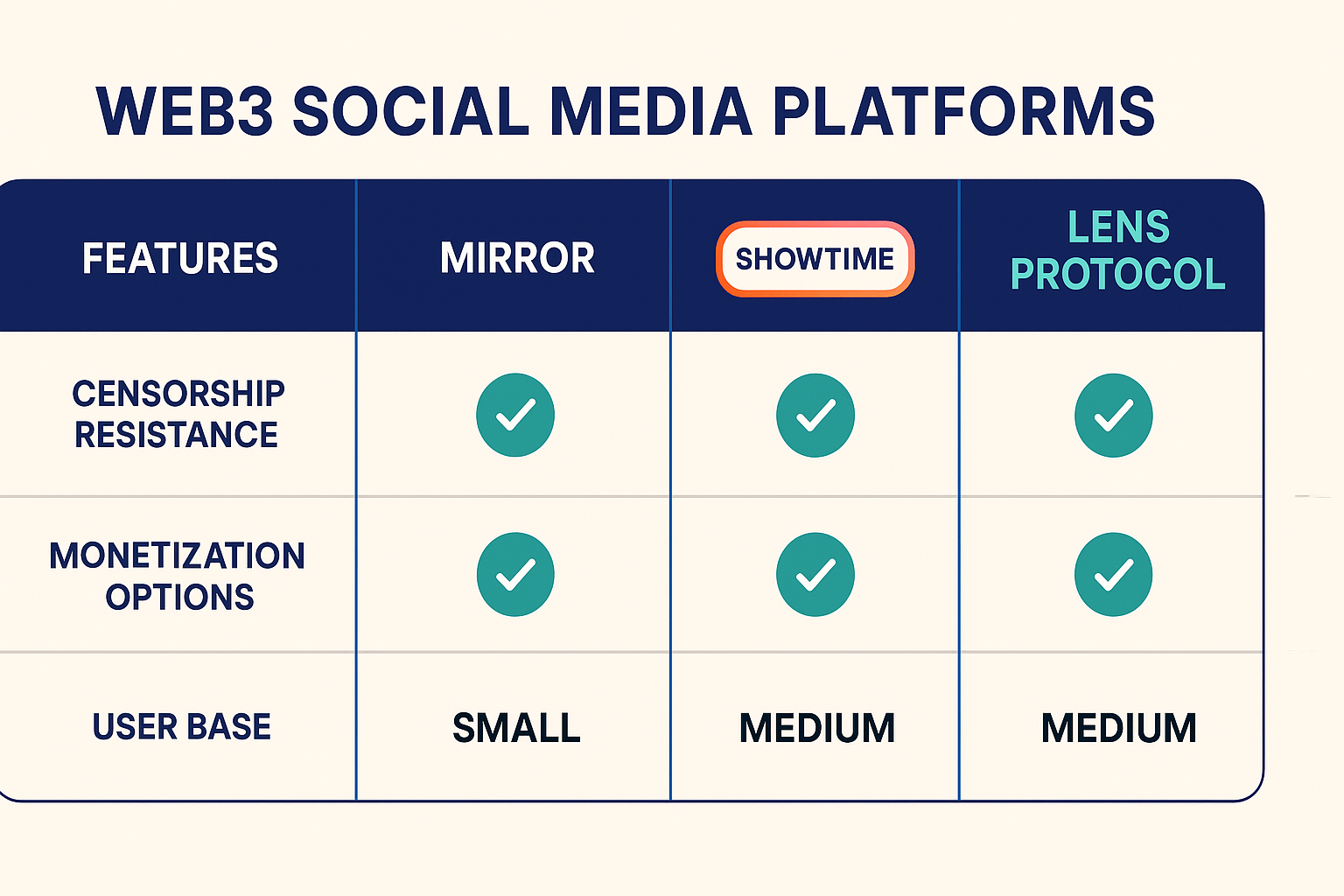
Top Web3 Social Media Platforms
The Web3 social media landscape is rapidly evolving, featuring a diverse range of platforms that cater to different user needs and decentralization philosophies. Each platform offers unique features, varying degrees of censorship resistance, and distinct monetization models, collectively pushing the boundaries of online interaction.
Leading Platforms Overview
Several platforms have emerged as frontrunners in the Web3 social media space, each with its own approach to decentralization and user experience. Lens Protocol, for instance, is a composable social graph that allows users to own their connections and content, making it portable across various applications built on the protocol. Showtime is another notable platform focusing on the creator economy, particularly for artists and collectors in the NFT space, offering robust tools for showcasing and monetizing digital art. Mirror.xyz has gained a reputation as a decentralized publishing platform where writers can mint their articles as NFTs, directly monetize their work through subscriptions or sales, and build communities around their content. Other platforms are exploring diverse models, from decentralized video sharing to audio-based social networks, all aiming to create more equitable ecosystems for creators and users alike. These platforms are foundational to the new era of user-owned social media.
Censorship Resistance and Security
A core tenet of Web3 social media is its inherent censorship resistance, achieved through decentralized architecture and robust security measures. Unlike Web2 platforms that can arbitrarily remove content or ban users based on centralized policies, Web3 networks distribute data across numerous nodes, making it exceedingly difficult for any single entity to censor information. Technologies like the InterPlanetary File System (IPFS) and Arweave ensure that content, once published, is stored immutably and remains accessible. Security is further bolstered by blockchain's cryptographic principles, ensuring data integrity and user authenticity. Community governance via DAOs also plays a role, allowing collective decision-making on content moderation policies, which, while still evolving, aims to be more transparent and community-driven than top-down approaches. This layered approach creates a more resilient environment for free expression.
User Monetization Models
Web3 social media platforms have revolutionized how creators and users can monetize their online presence. Traditional models often rely on advertising revenue, which benefits platforms more than creators. Web3 platforms, however, enable direct monetization through various mechanisms. Token rewards are common, where users can earn platform-native tokens for creating or engaging with content. Social tokens allow creators to launch their own branded currencies, offering exclusive access or benefits to token holders and creating a direct economic relationship with their fanbase. NFTs (Non-Fungible Tokens) provide a way for creators to sell unique digital assets, such as artwork, articles, or exclusive posts, establishing verifiable digital ownership. Furthermore, direct tipping, fan subscriptions, and even fan investment in creator success through token sales are becoming increasingly prevalent, fostering deeper engagement and a more sustainable creator economy.
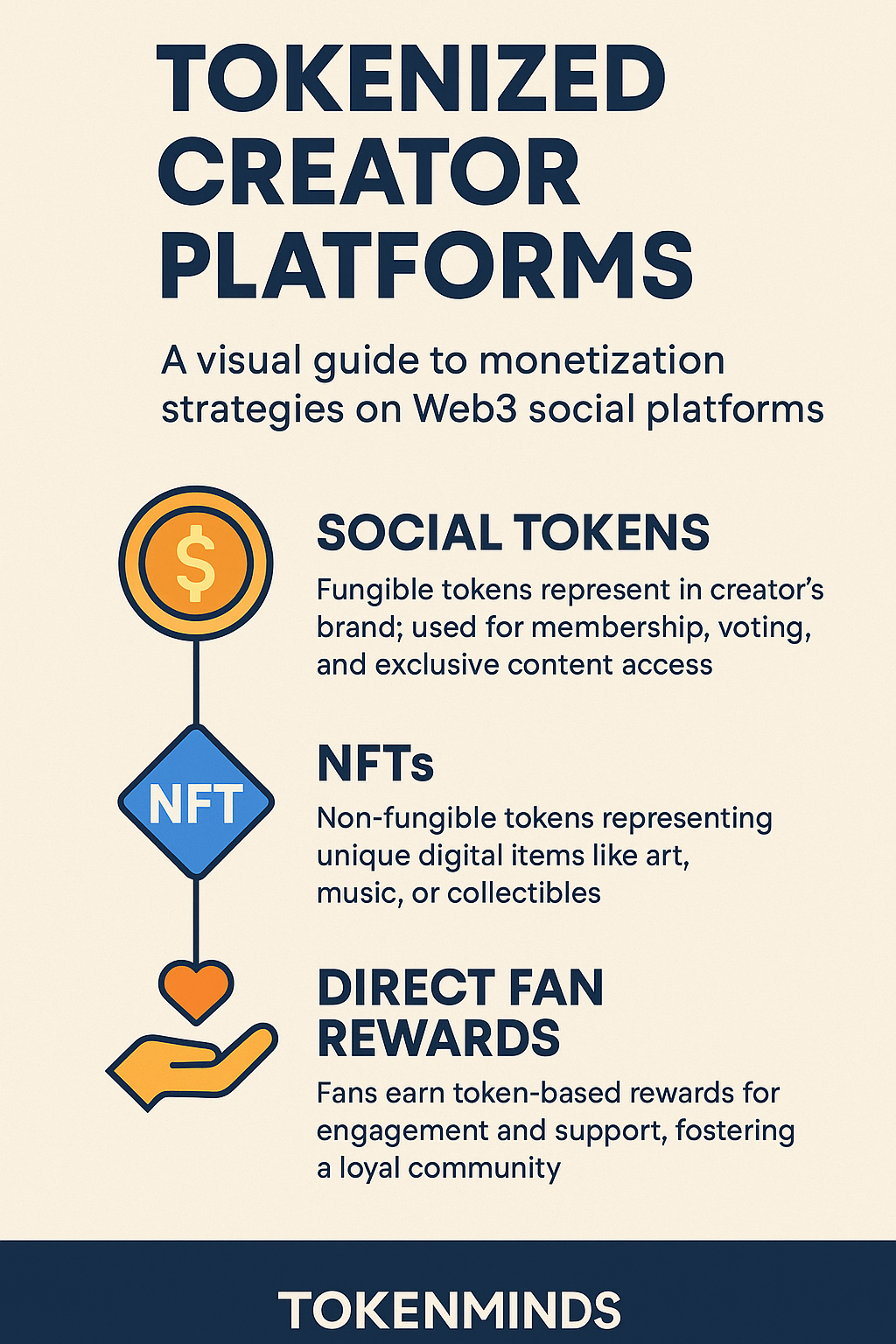
How Decentralized Social Networks Work
Understanding the underlying technology of decentralized social networks reveals how they differ fundamentally from their centralized Web2 counterparts. These platforms leverage blockchain and related technologies to create a more transparent, secure, and user-controlled environment.
Core Blockchain Technologies
At the heart of decentralized social networks are blockchain technologies, which provide a distributed, immutable ledger for recording transactions and data. Unlike traditional databases stored on single servers, a blockchain distributes information across a network of computers (nodes). This distributed ledger technology (DLT) ensures that data is tamper-proof and transparent; once a record is added, it cannot be altered or deleted without consensus from the network. Cryptographic security is fundamental, using advanced encryption techniques to secure user data, verify transactions, and authenticate users. Decentralized data storage solutions, such as IPFS or Arweave, are often used to store the actual content (like posts, images, or videos) off-chain, with only references stored on the blockchain, enhancing scalability and privacy while still ensuring content availability and integrity.
Smart Contracts and DAOs
Smart contracts are self-executing programs stored on the blockchain that automate agreements and actions when predefined conditions are met. In Web3 social networks, smart contracts manage everything from content distribution rules and royalty payments to user interactions and governance voting. They ensure that transactions and operations occur transparently and without the need for intermediaries, reducing costs and potential points of failure. Decentralized Autonomous Organizations (DAOs) complement smart contracts by providing a framework for community governance. Token holders or members within a DAO can propose and vote on platform changes, content moderation policies, or feature development. This decentralized approach to decision-making empowers users, fosters community ownership, and inherently enhances censorship resistance by distributing control away from a single entity.
Interoperability Across Platforms
Interoperability is a critical concept in Web3, referring to the ability of different blockchain protocols and decentralized applications (dApps) to communicate, share data, and work together seamlessly. In the context of social media, this means users could potentially move their social graph, content, and identity across various Web3 platforms without losing their connections or data. Protocols like Lens Protocol are designed with interoperability in mind, creating a composable social graph that developers can build upon, fostering a more integrated and less fragmented ecosystem. This cross-platform compatibility is vital for user adoption, allowing individuals to switch or utilize multiple decentralized services without the data silos common in Web2, ultimately contributing to a more open and connected decentralized internet.
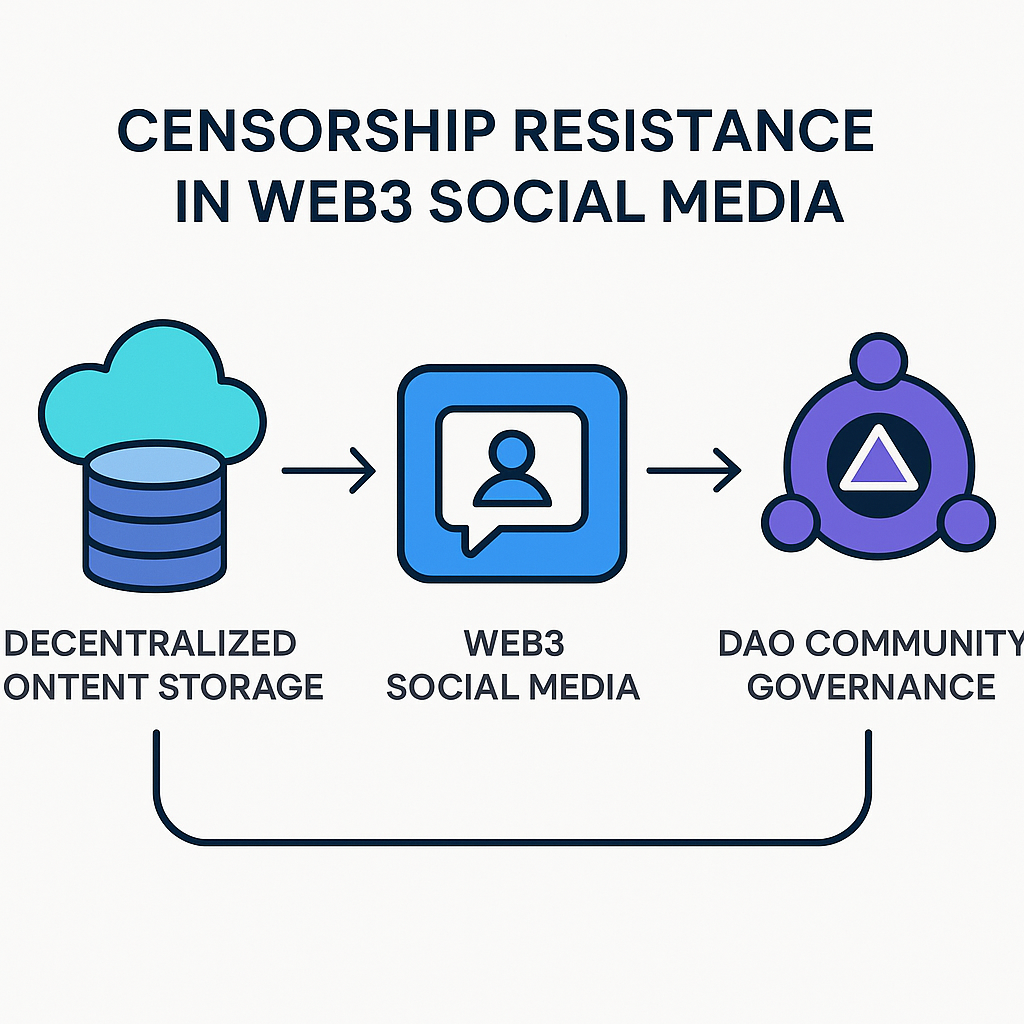
Monetizing Content on Web3 Social Platforms
Web3 social platforms offer a paradigm shift in how content creators can earn from their work, moving away from ad-centric models to more direct, creator-focused monetization strategies.
Tokenized Content Creator Platforms
Tokenized content creator platforms are emerging as powerful ecosystems where creators can leverage blockchain technology to build direct economic relationships with their audience. These platforms allow creators to issue and manage their own social tokens, which fans can acquire to gain access to exclusive content, community perks, or even participate in governance decisions related to the creator's output. This model bypasses traditional intermediaries, such as social media giants or payment processors, thereby reducing fees and giving creators more control over their earnings. Platforms like Mirror.xyz, where articles can be minted as NFTs, or those that support social token creation, enable creators to monetize their intellectual property directly, fostering a creator-centric economy that rewards value creation and community engagement more equitably.
Social Tokens and NFTs
Social tokens and NFTs (Non-Fungible Tokens) are transformative tools for creators in the Web3 space. Social tokens represent a creator's community or brand, granting holders specific rights or benefits like access to private chats, early releases, or voting power. By holding a creator's social token, fans become active participants in their success. NFTs, on the other hand, provide verifiable proof of ownership for unique digital or physical assets. Creators can tokenize their art, music, videos, or even exclusive pieces of content as NFTs, making them tradable assets. This not only offers a new revenue stream through-direct sales and royalties on secondary market transactions but also allows fans to interm invest in and collect unique digital memorabilia directly from their favorite creators, forging deeper connections and enabling novel forms of fan engagement.
Direct Fan Engagement and Rewards
A significant advantage of Web3 social media platforms is the ability to foster direct fan engagement and rewards, creating stronger communities and lastmore sustainable monetization channels. Unlike Web2 platforms where interactions are often mediated by algorithms and advertising, Web3 enables direct peer-to-peer interactions and value exchange. Creators can implement sophisticated tipping systems using cryptocurrencies, allowing fans to show appreciation seamlessly. Beyond tipping, platforms facilitate reward programs where users might earn tokens for engagement, content creation, or community participation. Some models even allow fans to invest in a creator's potential success through social tokens or by collecting their NFTs, aligning incentives and building a loyal supporter base. This direct relationship empowers creators with predictable income streams and cultivates a more invested and appreciative audience.
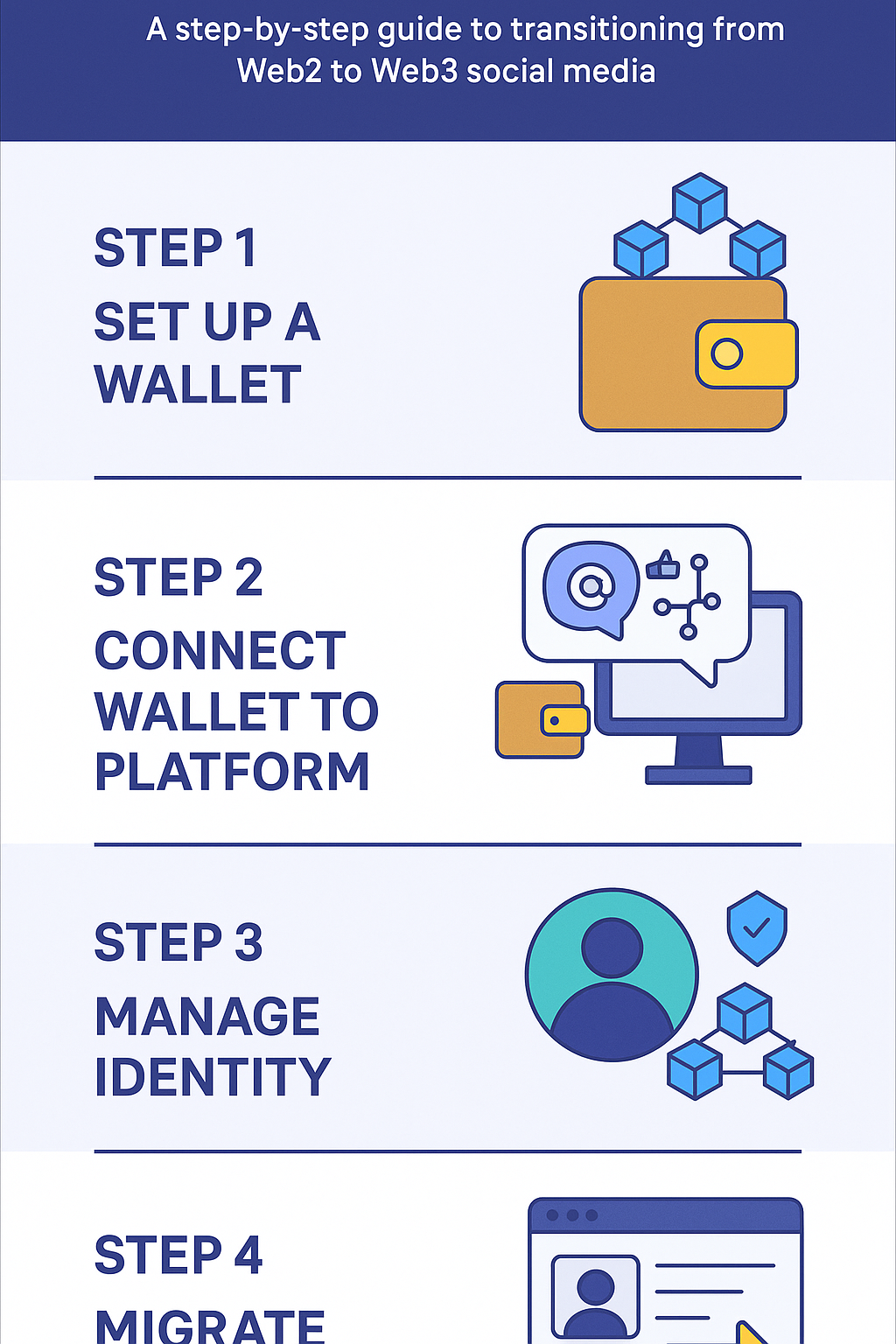
Censorship Resistance in Web3 Social Media
Censorship resistance is a cornerstone of Web3 social media, representing a significant departure from the centralized control often exercised on Web2 platforms. This resilience is built into the very architecture of decentralized networks.
Decentralized Content Storage
Decentralized content storage is a critical mechanism for achieving censorship resistance. Instead of storing data on a single company's servers, Web3 platforms utilize distributed file systems like IPFS or Arweave. Content, such as text posts, images, and videos, is broken down into pieces and distributed across a network of independent computers. Each piece is cryptographically hashed, ensuring its integrity and uniqueness. When content is requested, it can be retrieved from any node on the network that has a copy. This distribution makes it virtually impossible for any single entity—be it a platform administrator or a government—to remove or block content entirely, as it exists redundantly across numerous locations. This immutability and distributed nature ensures that information remains accessible and preserves freedom of expression.
Community Governance via DAOs
Community governance through Decentralized Autonomous Organizations (DAOs) is another powerful tool for censorship resistance. In a DAO structure, decisions regarding platform rules, content moderation policies, and operational guidelines are made collectively by the community members, typically through token-based voting. This democratic process replaces the top-down control found in centralized platforms. When faced with a decision about content, the community can vote on whether to remove it, flag it, or leave it accessible, rather than adhering to the arbitrary or biased decisions of a central authority. This decentralized decision-making process empowers users, ensures transparency, and makes the platform more resilient to external pressures that might seek to censor specific viewpoints or information.
Real-World Examples
Platforms like Mirror.xyz and Showtime exemplify the practical application of censorship resistance in Web3 social media. Mirror, a decentralized publishing platform, allows writers to monst mint their articles as NFTs. The content is stored on decentralized networks, and ownership is recorded on the blockchain, making it resistant to takedowns. Writers can directly monetize their work, and community ownership is facilitated through various features that can be governed by the community. Showtime focuses on artists and collecollectors, using blockchain to verify Pentium ownership of digital art and facilitate trading. By leveraging decentralized storage and blockchain-based ownership, these platforms create environments where creators have more control over their content and are less susceptible tolanması censorship. These case studies highlight how Web3 principles can foster more open and resilient social ecosystems.

Migrating from Web2 to Web3 Social Media
Transitioning from the familiar landscape of Web2 social media to the burgeoning world of Web3 requires careful consideration of technical steps, identity management, and best practices to ensure a smooth and secure migration.
ersenSteps to Transition
The migration process involves several key steps to get users fully engaged with Web3 social platforms. The initial step is typically setting up a crypto wallet, such as MetaMask or WalletConnect compatible wallets, which will serve as the user's digital identity and primary tool for interacting with decentralized applications (dApps). Next, users need to acquire native cryptocurrency for transaction fees (gas) on the relevant blockchain. Creating a profile on a Web3 social platform usually involves connecting this wallet and then potentially minting a decentralized identifier (DID) or creating a platform-specific identity linked to the wallet. Importing existing content or follower lists can be challenging due to interoperability limitations, but platforms are increasingly developing tools to facilitate this. Users should also familiarize themselves with the platform’s governance mechanisms and tokenomics.
Wallet Integration and Identity Management
Wallet integration is the gateway to the Web3 ecosystem. Non-custodial wallets, which give users full control over their private keys and digital assets, are fundamental. These wallets are used to sign transactions, interact with smart contracts, and authenticate users on dApps without revealing sensitive personal information directly to the platform. Decentralized identity management is also crucial. Instead of relying on traditional usernames and passwords managed by a central entity, Web3 uses self-sovereign identity approaches. This often involves DIDs, which are unique identifiers registered on a blockchain and controlled by the user. A user's profile, reputation, and data can be associated with their DID, allowing them to present verified credentials selectively across different platforms, enhancing both privacy and portability of their digital self.
Challenges and Best Practices
Migrating to Web3 social media presents several challenges, including a steeper learning curve compared to Web2, especially concerning wallet management and understanding blockchain transactions. Usability remains a key hurdle, as interfaces need to be intuitive for mainstream adoption. Interoperability issues can also arise, limiting seamless data transfer between different dApps. Security is paramount; users must protect their wallet's private keys diligently, as loss of these keys means loss of access to assets and identity. Best practices for a successful transition include starting with familiar platforms that offer Web3 integrations, educating oneself on basic blockchain concepts and security measures, and always prioritizing wallet security. Engaging with platform communities for support and guidance is also highly recommended, as collective knowledge can help navigate the complexities of the decentralized web.
AI-Powered Web3 Tools Enhancing Social Media
The integration of Artificial Intelligence (AI) with Web3 social media platforms promises to enhance user experiences, streamline operations, and bolster security, all while aligning with the core principles of decentralization and user empowerment.
Automation in Content Moderation
AI is playing an increasingly vital role in automating content moderation within decentralized social networks. Unlike centralized platforms that rely heavily on human moderators or rigid algorithms, Web3 platforms can leverage AI to analyze content in real-time, identify harmful material, detect spam, and flag policy violations with greater efficiency and scalability. AI models can be trained on vast datasets to recognize patterns associated with misinformation, hate speech, or malicious bot activity. Crucially, in a Web3 context, AI moderation systems can operate under transparent, community-approved guidelines, often managed via DAOs. This ensures that moderation decisions are less arbitrary and more aligned with the collective will of the platform's users, maintaining platform integrity without compromising the decentralized ethos.
Personalized Decentralized Feeds
AI algorithms are also instrumental in creating personalized decentralized feeds, tailoring content discovery to individual user preferences. While traditional platforms use opaque algorithms that can lead to echo chambers or biased content delivery, Web3 aims for transparency. AI in decentralized environments can analyze user behavior, content interactions, and preferences to curate relevant content feeds. This can be achieved through privacy-preserving techniques, such as federated learning, where AI models are trained on user data locally on their devices without the data ever leaving the user investigated's control. This approach enhances content relevance and discovery while upholding the core Web3 values of user privacy and data ownership, offering a more tailored and trustworthy social media experience.
Security and Fraud Detection
In the Web3 ecosystem, security and fraud detection are paramount, and AI offers powerful solutions to these challenges, particularly within decentralized social platforms. AI can be employed to identify and mitigate various threats, including phishing attempts, fake accounts, and malicious smart contract interactions. By analyzing patterns in transaction data, user behavior, and network activity, AI algorithms can detect anomalies that indicate fraudulent activity, such as coordinated inauthentic behavior or scams. For instance, AI can help identify newly created accounts exhibiting bot-like behavior or flag suspicious links shared within posts. Integrating such AI-determined driven security measures with blockchain's inherent transparency and immutability creates a more robust defense against bad actors, safeguarding users and the integrity of the decentralized social network.
Conclusion and Next Steps
The journey through Web3 social media reveals a dynamic ecosystem poised to redefine online interaction, offering users unprecedented ownership, control, and opportunities for monetization. The shift from centralized Web2 platforms to decentralized Web3 alternatives marks a significant evolution in how we connect, share, and interact online.
Recap of Web3 Social Media Benefits
We've explored how platforms built on blockchain technology empower users with true data ownership and robust censorship resistance. The integration of tokenization, smart contracts, and DAOs facilitates innovative monetization models for creators, allowing for direct fan engagement and equitable value distribution. These advancements collectively contribute to a more transparent, secure, and user-centric social media landscape, fostering open communities and empowering individual expression without the constraints of traditional intermediaries.
Future Trends to Watch
The future of Web3 social media is bright with emerging trends. Expect further advancements in AI integration for enhanced personalization, content moderation, and security within decentralized frameworks. We will likely see increased interoperability between platforms, creating a more seamless user experience and expanding the utility of social graphs and digital identities. The evolution of token economies, including social tokens and NFTs, will continue to unlock new avenues for creators and communities. Additionally, greater emphasis on user privacy through zero-knowledge proofs and advanced encryption will likely shape the development of more secure and trustworthy decentralized social networks.
Call to Action
Now is the opportune moment to explore the exciting possibilities of Web3 social media platforms. Whether you are a content creator looking to monetize your work directly, a user seeking greater control over your data and online identity, or simply curious about the future of the internet, diving into these decentralized networks is a valuable step. Start by exploring platforms like Lens, Mirror, or Showtime. Secure a Web3 wallet, familiarize yourself with the basics of blockchain interaction, and begin building your presence in this new digital frontier. Embrace the potential of Web 3.0 and leverage the power of decentralization to shape your online experience.
References
- Full Guide – Web3 Social Media Platforms – Comprehensive overview of Web3 social media, including technical details and platform examples.
- Launch Your Own Web3 Social Media Platform: A Complete Guide – Guide on developing and launching decentralized social media platforms.
- List of 64 Web3 Social Media Dapps (2025) – Curated list of Web3 social media applications.
- Top Web3 Social Media Dapps (2025) – Web3 Wiki – Web3 wiki entry detailing top decentralized social applications.
- Mirror – Information about Mirror, a decentralized publishing platform.
- Connecting the Web3 Ecosystem | Hashtag Web3 – Insights into connecting various elements within the Web3 ecosystem.
- What is Web3 and why is it important? – Explanation of Web3 and its significance.
- Web3 Apps and Their Impact on Digital Ecosystems – Details on the impact of Web3 applications.
- Web 3.0: The Meaning and Future – Discussion on the meaning and future prospects of Web 3.0.
- Exploring Lens Protocol: The Future of Decentralized Social Graphs – In-depth look at Lens Protocol and its role in decentralized social networking.
- The Business Case for Decentralized Social Media and Why It Matters Now – Analysis of the business benefits and importance of decentralized social media.
- Decentralizing social media: a guide to the web3 social stack – A guide to the technological components of decentralized social media.
- Mastering Lens Protocol: Everything You Need to Know – Comprehensive guide to understanding and using Lens Protocol.
- Web3 Social: Road to Mass Adoption – A report discussing Web3 social media and its path to mass adoption.
- What is a Search Query? (Definition) – SEO Glossary – Definition and explanation of search queries in the context of SEO.
- Search Query Definition – Page One Power – An alternative definition of a search query.
- Google Search Operators: The Complete List (44 Advanced …) – A guide to Google's advanced search operators for refined queries.
- Match query | Elastic Documentation – Documentation on the Elasticsearch `match` query for full-text search.
- Query string query | Reference – Elastic – Documentation on the Elasticsearch `query_string` query for complex searches.
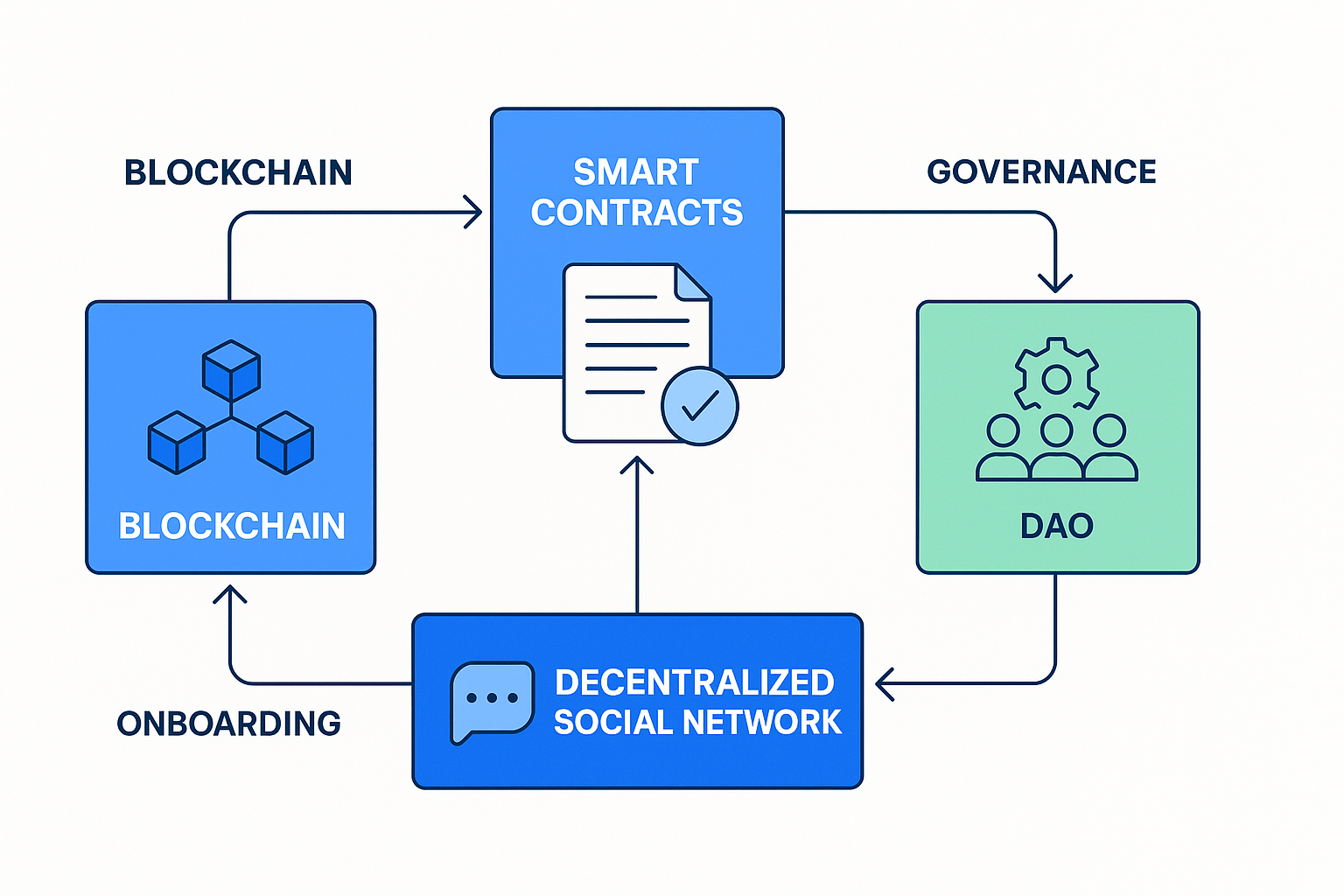
Leave a Reply